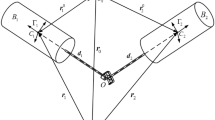Abstract
The attitude optimal control problem (OCP) of a two-rigid-body spacecraft with two rigid bodies coupled by a ball-in-socket joint is considered. Based on conservation of angular momentum of the system without the external torque, a dynamic equation of three-dimensional attitude motion of the system is formulated. The attitude motion planning problem of the coupled-rigid-body spacecraft can be converted to a discrete nonlinear programming (NLP) problem using the Chebyshev-Gauss pseudospectral method (CGPM). Solutions of the NLP problem can be obtained using the sequential quadratic programming (SQP) algorithm. Since the collocation points of the CGPM are Chebyshev-Gauss (CG) points, the integration of cost function can be approximated by the Clenshaw-Curtis quadrature, and the corresponding quadrature weights can be calculated efficiently using the fast Fourier transform (FFT). To improve computational efficiency and numerical stability, the barycentric Lagrange interpolation is presented to substitute for the classic Lagrange interpolation in the approximation of state and control variables. Furthermore, numerical float errors of the state differential matrix and barycentric weights can be alleviated using trigonometric identity especially when the number of CG points is large. A simple yet efficient method is used to avoid sensitivity to the initial values for the SQP algorithm using a layered optimization strategy from a feasible solution to an optimal solution. Effectiveness of the proposed algorithm is perfect for attitude motion planning of a two-rigid-body spacecraft coupled by a ball-in-socket joint through numerical simulation.
Similar content being viewed by others
References
Krishnaprasad, P. S. Geometric phases and optimal reconfiguration for multibody systems. American Control Conference, 1990, 2440–2444 (1990)
Chen, C. K. and Sreenath, N. Control of coupled spatial two-body systems with nonholonomic constraints. IEEE Conference on Decision and Control, 2, 949–954 (1993)
Kolmanovsky, I., McClamroch, N. H., and Coppola, V. T. New results on control of multibody systems which conserve angular momentum. Journal of Dynamical and Control Systems, 1, 447–462 (1995)
Reyhanoglu, M. and McClamroch, N. H. Planar reorientation maneuvers of space multibody systems using internal controls. Journal of Guidance Control and Dynamics, 15, 1475–1480 (1992)
Fernandes, C., Gurvits, L., and Li, Z. X. Near-optimal nonholonomic motion planning for a system of coupled rigid bodies. IEEE Transactions on Automatic Control, 39, 450–463 (1994)
Xia, Y. Q., Zhu, Z., Fu, M. Y., and Wang, S. Attitude tracking of rigid spacecraft with bounded disturbances. IEEE Transactions on Industrial Electronics, 58, 647–659 (2011)
Ge, X. S. and Guo, Z. X. Attitude motion planning of dual rigid bodies spacecraft using spline approximation. Scientia Sinica Physica Mechanica and Astronomica, 43, 407–414 (2013)
Ge, X. S. and Chen, L. Q. Optimal control of nonholonomic motion planning for a free-falling cat. Applied Mathematics and Mechanics (English Edition), 28, 601–607 (2007) DOI 10.1007/s10483-007-0505-z
Benson, D. A. A Gauss Pseudospectral Transcription for Optimal Control, Ph. D. dissertation, Massachusetts Institute of Technology, Cambridge, 1–243 (2005)
Benson, D. A., Huntington, G. T., Thorvaldsen, T. P., and Rao, A. V. Direct trajectory optimization and costate estimation via an orthogonal collocation method. Journal of Guidance Control and Dynamics, 29, 1435–1439 (2006)
Fahroo, F. and Ross, I. M. Direct trajectory optimization by a Chebyshev pseudospectral method. Journal of Guidance Control and Dynamics, 25, 160–166 (2002)
Gong, Q., Ross, I. M., and Fahroo, F. Costate computation by a Chebyshev pseudospectral method. Journal of Guidance Control and Dynamics, 33, 623–628 (2010)
Darby, C. L., Hager, W. W., and Rao, A. V. An hp-adaptive pseudospectral method for solving optimal control problems. Optimal Control Applications and Methods, 32, 476–502 (2011)
Darby, C. L., Hager, W. W., and Rao, A. V. Direct trajectory optimization using a variable low-order adaptive pseudospectral method. Journal of Spacecraft and Rockets, 48, 433–445 (2011)
Tang, X. J., Wei, J. L., and Chen, K. A Chebyshev-Gauss pseudospectral method for solving optimal control problems. Acta Automatica Sinica, 41, 1778–1787 (2015)
Shang, Y. D. and Guo, B. L. Analysis of Chebyshev pseudospectral method for multi-dimensional generalized SRLW equations. Applied Mathematics and Mechanics (English Edition), 24, 1168–1183 (2003) DOI 10.1007/BF02438106
Afify, A. A. and Elgazery, N. S. Effect of double dispersion on non-Darcy mixed convective flow over vertical surface embedded in porous medium. Applied Mathematics and Mechanics (English Edition), 34, 1247–1262 (2013) DOI 10.1007/s10483-013-1742-6
Zhuang, Y. F. and Huang, H. B. Time-optimal trajectory planning for underactuated spacecraft using a hybrid particle swarm optimization algorithm. Acta Astronautica, 94, 690–698 (2014)
Huang, X., Yan, Y., Zhou, Y., and Zhang, H. Pseudospectral method for optimal propellantless rendezvous using geomagnetic Lorentz force. Applied Mathematics and Mechanics (English Edition), 36, 609–618 (2015) DOI 10.1007/s10483-015-1936-7
Broutman, D. A practical guide to pseudospectral methods. Journal of Fluid Mechanics, 360, 375–378 (1998)
Fernandes, C., Gurvits, L., and Li, Z. X. Attitude control of a space platform/manipulator system using internal motion. International Journal of Robotics Research, 13, 289–304 (1994)
Shabana, A. A. Dynamics of Multibody Systems, 4th ed., Cambridge University Press, Cambridge, 58–59 (2013)
Isidori, A. Nonlinear Control Systems II, Springer-Verlag, Berlin, 1–74 (1999)
Weideman, J. and Trefethen, L. The kink phenomenon in FejWr and Clenshaw-Curtis quadrature. Numerische Mathematik, 107, 707–727 (2007)
Berrut, J. P. and Trefethen, L. N. Barycentric Lagrange interpolation. SIAM Review, 46, 501–517 (2004)
Costa, B. and Don, W. S. On the computation of high order pseudospectral derivatives. Applied Numerical Mathematics, 33, 151–159 (2000)
Trefethen, L. N. Is Gauss quadrature better than Clenshaw-Curtis? SIAM Review, 50, 67–87 (2008)
Waldvogel, J. Fast construction of the FejWr and Clenshaw-Curtis quadrature rules. BIT Numerical Mathematics, 46, 195–202 (2006)
Author information
Authors and Affiliations
Corresponding author
Additional information
Project supported by the National Natural Science Foundation of China (No. 11472058)
Rights and permissions
About this article
Cite this article
Ge, X., Yi, Z. & Chen, L. Optimal control of attitude for coupled-rigid-body spacecraft via Chebyshev-Gauss pseudospectral method. Appl. Math. Mech.-Engl. Ed. 38, 1257–1272 (2017). https://doi.org/10.1007/s10483-017-2236-8
Received:
Revised:
Published:
Issue Date:
DOI: https://doi.org/10.1007/s10483-017-2236-8



